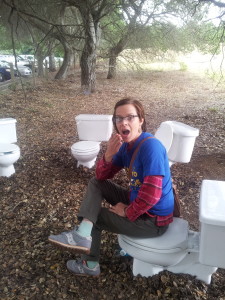Enacting Awareness: Water, Waste, and Public Space
With last Friday’s whimsical 5K walk, activists at the University of California at Santa Cruz focused attention on often-evaded issues. “Slugs to Sludge” was created as a playful way to raise awareness of sewage infrastructure and the water it requires, and to advocate for action on ecological sanitation at UCSC and beyond. With the average American flushing away an estimated annual 5 thousand gallons of drinking water in a time of drought, sanitation clearly needs to be central to the dialogue. Walkers followed the path of human waste from the campus to the wastewater treatment facility at Neary Lagoon, having fun along the way in with activities organized by various environmental groups.
Slugs to Sludge serves as an invitation to a May 28th event entitled “Enacting Awareness: Water, Waste, and Public Space“. A series of presentations and a panel discussion will feature a dynamic mix of artists, scholars, and creative practitioners working on cultural and environmental aspects of human waste, ecological education, and organizing. Joining UCSC PhD student Abigail Brown of PHLUSH are Heidi Quante of Creative Catalysts, Shawn Shafner of The People’s Own Organic Power Project, and author and ecological sanitation advocate Carol Steinfeld. Both events were organized by the UCSC Wastewater Research Group, led by Digital Arts and New Media graduate students Andrea Steves and Timothy Furstnau, with support from the Art Department and Arts Division.

Porcelain toilets greet walkers at the Slugs to Sludge starting line at the University of California Santa Cruz.

Participants take a quick rest before beginning the 5k pilgrimage to the wastewater treatment plant.

Where was your last poop in Santa Cruz? How will it co-mingle with the movements of 80.000 others the treatment plant serves?

The sewage outflow pipe from University of California Santa Cruz lies along the base of a large ravine. Human impact collides with Nature.







